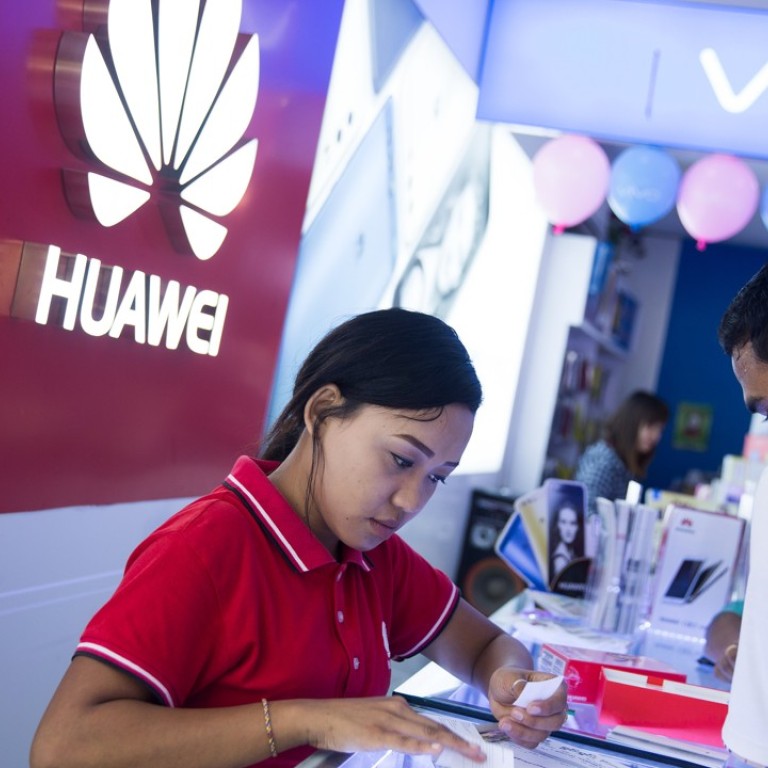
Huawei boosts retail channels to stem margin decline
The telecoms equipment maker says it would have opened 56,000 retail stores worldwide by the end of 2017 to sell more devices to counter slipping margins
To counter the continuous margin squeeze, Huawei Technologies is accelerating the pace of opening new stores globally to sell more smartphones, with a plan to run 56,000 retail stores worldwide by the end of 2017, up from 35,000 in May last year.
The expansion of its retail channel expansion was backed by strong growth in smartphone sales, as Huawei shipped a total of 73 million units of mobile devices in the first six months this year, up 20.6 per cent from the same period last year, due to strengthened presence in its home market, Europe and the Southeast Asian regions, the Shenzhen-based company said in a statement on Thursday.
It could also buffer the slide in operating margins which fell to 11 per cent in the first-half of 2017, from 12 per cent and 18 per cent for the corresponding periods in 2016 and 2015, respectively.
Sales revenue from the consumer business group – its terminal product segment including smartphones and tablets – increased 36.2 per cent to reach 105.4 billion yuan (US$15.6 billion) during the first half, it said.
“The growth rate of sales revenue is higher than that for shipment, as Huawei has sold more high-end smartphone models in the first half of this year,” Yu Chengdong, CEO of Huawei’s consumer business group, said in Shenzhen on Thursday.

Those in Europe, another key market for Huawei, rose 18 per cent, year-on-year growth, with robust growth in Central and Eastern Europe, the company said without providing any further breakdown.
Huawei said it accounted for 14 per cent of all smartphones priced above US$500 that were sold globally as of this May, compared with a5.8 per cent share a year earlier.
“Huawei’s smartphone brand is still at an investment period, but its profitability is improving and we are making positive contribution to the group,” said Yu.
Huawei’s smartphone brand is still at an investment period, but its profitability is improving and we are making positive contribution to the group
Huawei’s retail channel expansion underscored its difficulty in stemming decline in profit margins over the years.
Yu added that not all 56,000 retail stores would be operated directly by them, as a majority of the stores will be run by partners.
The Chinese technology giant also announced on Thursday that group’s revenue rose 15 per cent to 283.1 billion yuan in the first half of 2017, against the same period in 2016.
It didn’t disclose its first-half net profit.
The company acknowledged that its expansion of offline sales channels expansion previously and higher marketing expenditure had hurt profitability. It said in March that net profit margin fell to 7.1 per cent in 2016, from 9.3 per cent in 2015.

Yu admitted that the “golden era” for smartphone brands might have ended as the global handset sales only expanded 2.3 per cent in 2016, compared with expansions of 10.1 per cent in 2015 and 27.7 per cent in 2014.
Huawei, the world’s third-largest smartphone vendor after Samsung and Apple, owns 9.8 per cent of global market share in the first quarter of 2017, up from 8.4 per cent in the same period last year, according to research agency IDC.
Yu expects their share of the market to exceed 10 per cent by the end of this year.
Canalys data released this week indicated that Huawei shipped 23 million smartphones in the domestic market in the three months ended June, the best-selling smartphone brand in China for the second straight quarter.
Huawei’s market share in smartphone sales in China was 20.2 per cent as of the end of June, from 16.9 per cent a year earlier, according to Counterpoint’s data.

